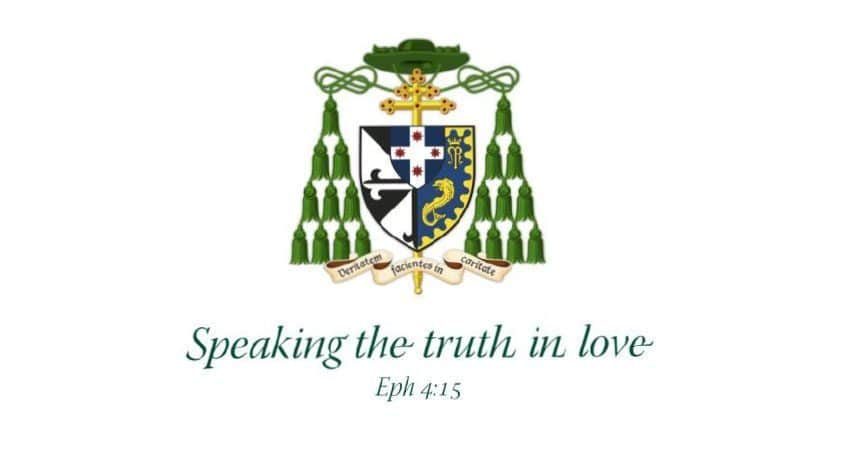HOMILY FOR MASS FOR 33RD SUNDAY OF ORDINARY TIME YEAR C + INVESTITURE OF A CHAPLAIN OF THE EQUESTRIAN ORDER OF THE HOLY SEPULCHRE OF JERUSALEM

St Mary’s Basilica, Sydney
This past week a pall of smoke hung over our city, as the Sydney, Illawarra and Hunter regions were alerted that they were in “Catastrophic Fire Danger”. High temperatures and strong winds were forecast for a region already dried by drought. Thousands of fire-fighters were deployed and the army readied. Many schools and roads were closed. Some places were evacuated. Across the state hundreds of fires blazed. Homes, properties, live-stock were lost in the inferno. The NSW Rural Fire Service warned Sydneysiders: “For your survival, leaving bushfire prone areas early is the only option. Do not just wait and see what happens.”[1] The apocalyptic language was worthy of the Prophet Malachi who today warns that fire will fall upon the earth, burning it up as in a furnace (Mal 3:19-20). Drought and fire – as well as the earthquakes, plagues and famines predicted by Jesus (Lk 21:5-10) – all these things are portents…
Portents, yes, but of what? For the secular world fires and drought are auguries of climate change. More cautious scientists say you can’t connect the current drought or fires in any easy way to longer-term climate patterns. But something certainly seems to be going on in the heavens… and it’s not so good for us on earth.
There’s a moral dimension to this secular apocalypse. Along with the embers of this week’s maelstrom plenty of blame was blowing around too. Arsonists were presumed to have started the fires and others impugned for failing to clear away what fuelled them: farmers, rangers, politicians, greenies, all got fingers wagged at them. So did the human race: we were told we’re all to blame for climate change and for doing too little about it; we largely brought this “Apocalypse Now” upon ourselves. In those big letters with which nature often writes, these fiery omens seemed to underline our vulnerability and herald cataclysm unless we change…
For believers such physical signs should point to deeper realities. Extreme weather events, as we call them today, or ‘acts of God’ as insurers like to call them, are not only nature’s attention-getters: they underline that the natural world, fallen as it is, can be both beautiful and cruel; that either way it won’t necessarily last; that our created order is fragile and finite and will eventually come to its conclusion; and that the health, security and destiny of the human race is connected to that of our planetary ecology. And if this world may come to an end, so may any one of us. Like those outside us, the bushfires within – the sicknesses of body or soul – are premonitions of death. And every death, a reminder to survivors that mortality is their lot also. Every natural or more personal disaster confronts the believer with the question: if it all, or at least I, came to an end sometime soon, would I be ready?
So when Christians see bushfires or other devastation it should ring alarm bells, not just because of what might be lost but because we are personally implicated. As our Scriptures at this time of year make clear: what we do (or not) here and now can help bring on the end-times or at least determine where we’ll stand when they come.
The end of the liturgical cycle and the Advent season that opens the new liturgical year are times of apocalyptic prophecy as well as of eschatological promise. Yet the message is not ‘Get out!’ as is that of the fire authorities, even with a ‘for heaven’s sake’ attached. When Christians smell smoke, they should take seriously the moral and spiritual challenge that smoke intimates: Death, Judgment, Heaven and Hell. And the fire-rescue team that is our Church must prompt our consciousness of these inevitabilities and teach us preparedness.
Does it require disaster to shake us out of our complacency, to get us reflecting upon the end that’s nigh for the world or ourselves, to get us to change so we are ready for those four last things? Our readings suggest both danger and opportunity can be ‘disrupters’, both catastrophe and promise be wake-up calls. The fire’s heat burns up the wicked in Malachi’s prophecy, but its light shines upon the righteous (Mal 3:19-20). Persecution and imprisonment are the lot of the innocent in Jesus’ prophecy – as we see in our own times – but these, He says, can be opportunities for patience, endurance, witness (Lk 21:5-10). Nature’s thunder and lightning, according to our Psalmist, inspire awe and trembling; but they can also be the sounds of rivers clapping their hands and hills singing for joy that the Lord is coming (Ps 97:5-9).
Many things can indeed be eschatological signs, signs of the end, of the beginning of the end and of the new beginning that follows. Many things can be indicators that the Lord is coming to us and we are coming to the Lord. Extreme weather, catastrophic fire, war and persecution, these are powerful shaker-uppers: but so should be the beauty and generosity we normally experience in creation; so should be the encounter with divine and human goodness in the saints, in each other, even occasionally in ourselves; so should be our experiences of redemption through that Lord who came and is coming again “to bring fire upon the earth” (Lk 12:49).
Some years ago a young friar was confronted by someone highly critical of him for wearing his religious habit. His initial reaction was to ask the interlocutor whether he thought commenting on other people’s dress was courteous and whether he’d be equally belligerent towards a Buddhist monk or uniformed service-person… He then went on to explain why he wore his habit: it was, he said, so he could be “a living eschatological sign!”
Sounds rather grandiose, the sort of thing only a romantic youth would say, or someone who’d studied too much theology. Yet that young friar had a point. People should be signs to us of past times, of present times, of future times, indeed of the end-times, and signs every bit as powerful and shocking as any natural event. Instead of that smug and lazy self-indulgence that Paul critiques in today’s Epistle (2 Thes 3:7-12), we should let ourselves be shaken up and in turn be the ones to rouse our slumbering world. Our mission as Christians, as Jesus said and as St John XXIII repeated when convoking the Second Vatican Council,[2] is to read ‘the signs of the times’ in the world around us – and then to be such signs of the end-times to others.
INTRODUCTION TO MASS FOR 33RD SUNDAY OF ORDINARY TIME YEAR C + INVESTITURE OF A CHAPLAIN OF THE EQUESTRIAN ORDER OF THE HOLY SEPULCHRE OF JERUSALEM
St Mary’s Basilica, Sydney
Welcome to St Mary’s Cathedral for the Solemn Mass of the 33rd Sunday of Ordinary Time. This morning it is my privilege as Grand Prior of the NSW Lieutenancy of the Equestrian Order of the Holy Sepulchre of Jerusalem to invest Fr Paul Smithers into that ancient and noble order.
The Order is made up of 25,000 lay faithful devoted to building up the faith and practice amongst themselves in fidelity to the Pope and teachings of the Church; and to sustaining the spiritual, charitable and cultural works of the Church in the Holy Land, particularly those of the Latin Patriarchate. I’m pleased to acknowledge the Councillors, Chaplains, and other members and friends of the Order present this morning. In a great display of inter-order ecumenism, His Excellency the Prelate of the Sovereign Military and Hospitaller Order of Malta, Bishop Jean Laffitte, is concelebrating today and we welcome him to Australia.
Today we continue to pray for rain in our dry and burning land, for our fire-fighters and farmers, and for all affected. And, as it is November, we pray for our dear departed. To all our visitors, especially those from overseas, as well as our regulars, a very warm welcome!
[1] https://www.rfs.nsw.gov.au/plan-and-prepare/fire-danger-ratings
[2] Mt 16:3; Lk 12:56; St John XXIII, Humanæ Salutis; cf. St John XXIII, Pacem in Terris; Vatican Council II, Unitatis redintegatio 4; Dignitatis humanæ 15; Presbyterorum ordinis 9, Gaudium et spes 4.

